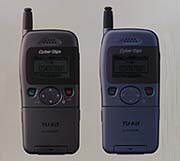|
Science & Technology || Sports & Fashion || Search || Back Numbers
EASY TALK: Next-Generation Portable Phones Hit the Market July 28, 1998  You can talk to these phones before you talk with them. (TU-KA Cellular Tokyo Inc.) The portable telephone market is abuzz with new models that can recognize some spoken words. Users can dial numbers on these cellular phones just by speaking into them. The last few years have seen great strides in miniaturization, making for smaller, lighter phones. But this has made them harder to handle, especially for older callers and others who have trouble seeing and pressing the tiny buttons. These people will be helped by the new voice-recognition technology, which is also being included in a forthcoming phone system worn like a wristwatch. Voice recognition could be a key technology as Japan's society continues to gray. Voice Recognition for Ease of Use Cellular phones with voice-recognition capabilities have been developed jointly by Kyocera Corp. and three companies of the Tu-ka Group. After storing names and numbers in the phone's memory, the user just speaks a name into the unit to dial that person's number. The newest model, only 18 mm thick and 112 mm long (0.7 and 4.4 inches, respectively), slips neatly into a shirt pocket, and is the first model in Japan to feature voice-recognition capability. The accuracy of the phone's voice recognition does depend to some extent on the surrounding noise level. In a quiet area, with ambient noise of around 35 decibels, the phone achieves up to 97% accuracy; in noisier areas like Tokyo's bustling major intersections, where background noise can approach 80 decibels, accuracy drops to around 70%. These phones were just released on the market in February 1998, but
have already become popular enough to boost sales to about 20,000 units
per month. The companies making the phones have received many inquiries
from visually impaired people and organizations supporting them. The
phones earned high marks when 10 of them were supplied to volunteers
at the Winter Paralympic Games, held in Nagano in March 1998. The consortium
notes that voice-recognition phones "should come in handy not only for
the elderly and visually impaired, but also for busy businesspeople,
for whom every second counts." The company was able to achieve this level of miniaturization by placing the voice-recognition elements on a single integrated chip. This single-chip construction also means low power consumption for the phone, which can be used for an hour of calling, or remain in call-reception mode for 100 hours, without recharging. NTT loaned 40 of these wristwatch phones to organizers of the February 1998 Olympic Winter Games, who put them through their paces in Nagano. The company expects to add even more features to the phone, which should hit the market in 1999.
 Edited by Japan
Echo Inc. based on domestic Japanese news sources. Articles
presented here are offered for reference purposes and do not
necessarily represent the policy or views of the Japanese
Government. Edited by Japan
Echo Inc. based on domestic Japanese news sources. Articles
presented here are offered for reference purposes and do not
necessarily represent the policy or views of the Japanese
Government.
|
